Levenhuk LabZZ MT2 User Manual [ru]
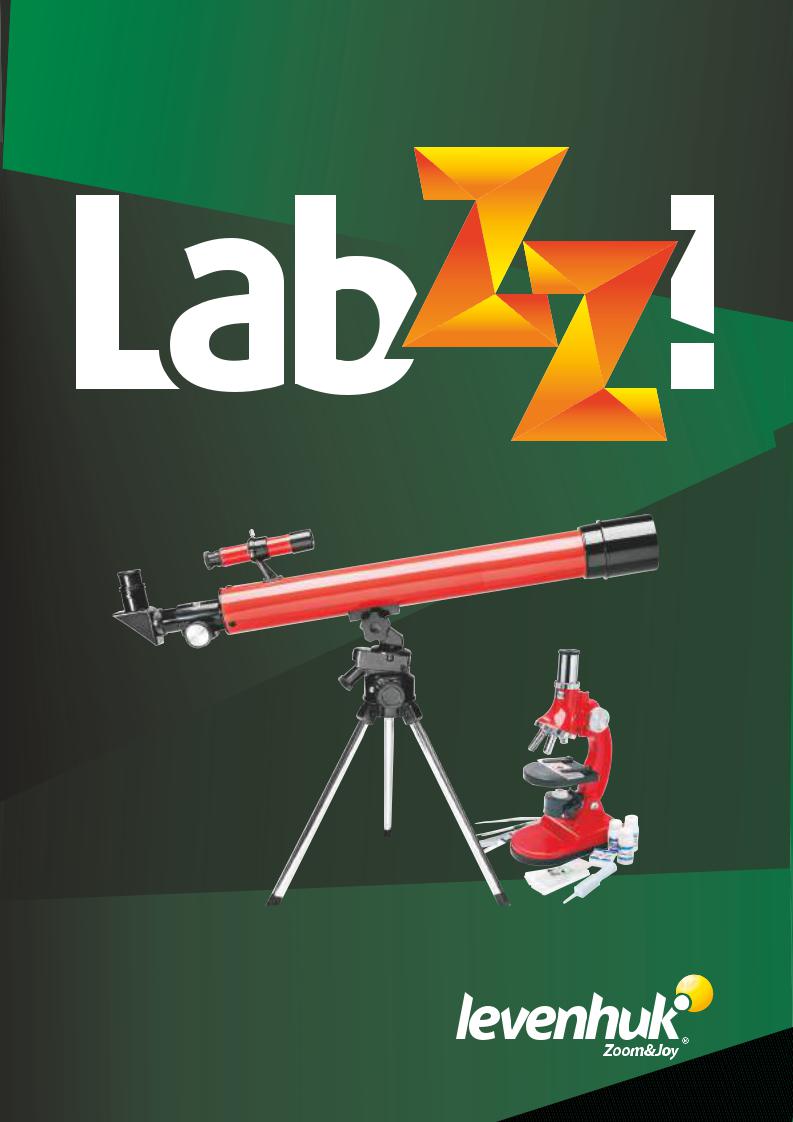
MICROSCOPE & TELESCOPE KIT
Levenhuk LabZZ MT2
User Manual Návod k použití
Bedienungsanleitung Guía del usuario Instrukcja obsługi
Инструкция по эксплуатации
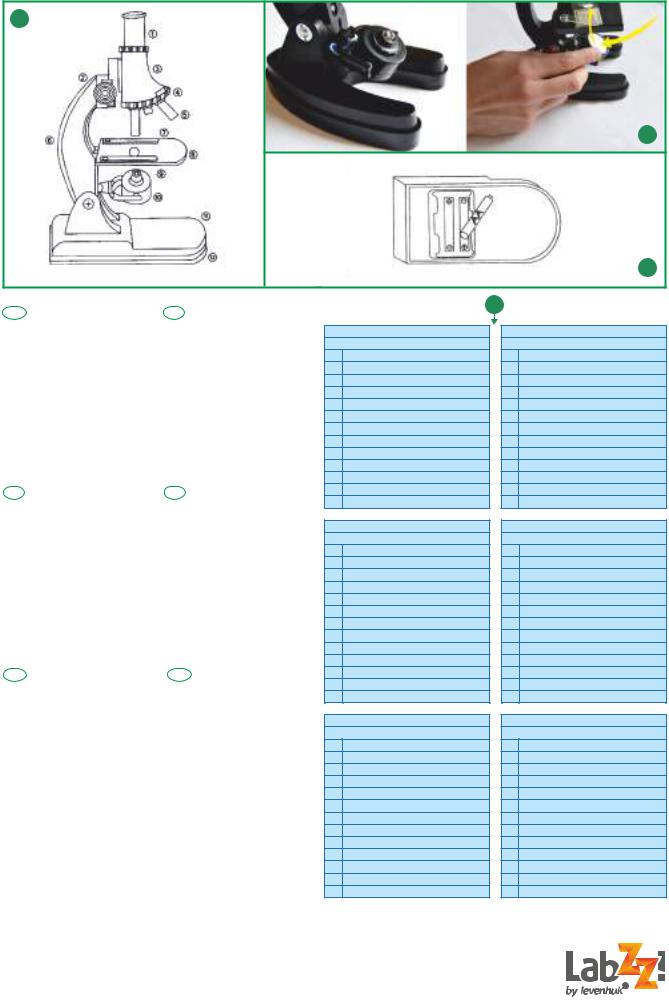
Levenhuk LabZZ 75x/300x/900x Microscope
1
2
3
EN |
CZ |
1. Eyepiece tube |
1. Tubus okuláru |
2. Focusing knob |
2. Zaostřovací šroub |
3. Microscope optical tube |
3. Optický tubus |
(monocular head) |
(monokulární hlava) |
4. Revolving nosepiece |
4. Revolverový nosič objektivů |
5. Objective |
5. Objektiv |
6. Stand |
6. Rameno |
7. Slide holder |
7. Držák preparátů |
8. Stage |
8. Pracovní stolek |
9. Illumination |
9. Osvětlení |
10. Mirror |
10. Zrcátko |
11. Battery compartment |
11. Prostor pro baterie |
12. Base |
12. Stativ |
DE |
|
ES |
1. |
Okularrohr |
1. Tubo ocular |
2. |
Fokussierrad |
2. Tornillo de enfoque |
3. |
Optischer Mikroskoptubus |
3. Tubo óptico del microscopio |
|
(Monokularkopf) |
(cabezal monocular) |
4. |
Objektivrevolver |
4. Revólver giratorio |
5. |
Objektiv |
5. Objetivo |
6. |
Stativgriff |
6. Soporte |
7. |
Probenhalter |
7. Pinza para portaobjetos |
8. |
Objekttisch |
8. Platina |
9. |
Beleuchtungslampe |
9. Iluminación |
10. |
Spiegel |
10. Espejo |
11. |
Batteriefach |
11. Compartimento de las pilas |
12. |
Sockel |
12. Base |
PL |
|
RU |
|
1. |
Tubus okularu |
1. |
Окулярная трубка |
2. |
Pokrętło ustawiania ostrości |
2. |
Ручка фокусировки |
3. |
Tuba optyczna |
3. |
Тубус микроскопа |
|
(Głowica monokularowa) |
4. |
Револьверное |
4. |
Głowica obrotowa |
|
устройство |
5. |
Obiektyw |
5. |
Объектив |
6. |
Statyw |
6. |
Штатив |
7. |
Uchwyt na preparaty |
7. |
Зажим |
8. |
Stolik |
8. |
Предметный столик |
9. |
Oświetlenie |
9. |
Лампа подсветки |
10. |
Lusterko |
10. |
Зеркало |
11. |
Komora baterii |
11. |
Батарейный отсек |
12. |
Podstawa |
12. |
Основание |
4
EN
The kit includes:
1microscope
3prepared microscope slides
3blank slides
5cover slips
5slide stickers
1scalpel
1forceps
1spatula
1dissecting needle 2 flask with dye
2 backup bulb
1flask with glue
1pipette
DE
Lieferumfang:
1Mikroskop
3Mikroskopierbereite Präparate
3Leere Objektträger
5Deckgläser
5Foliensticker
1Skalpell
1Forzeps
1Spatel
1Präpariernadel
2Kolben mit Farbe
2Ersatzlampe
1Kolben mit Klebstoff
1Pipette
PL
Zawartość zestawu:
1mikroskop
3gotowe próbki
3szkiełka podstawowe
5szkiełka nakrywkowe
5naklejki na preparaty
1skalpel
1peseta
1szpatułka
1igła preparacyjna 2 fiolka z barwnikiem
2 żarówka pomocnicza
1fiolka z klejem
1pipeta
CZ
Obsah soupravy:
1mikroskop
3preparáty připravené k použití
3čistá sklíčka
5krycí sklíčka
5samolepicí etikety na preparáty
1skalpel
1kleštičky
1stěrka
1preparační jehla
2nádobka s barvivem
2náhradní žárovka
1nádobka s lepidlem
1pipeta
ES
El kit incluye:
1microscopio
3muestras
3portaobjetos vacíos
5cubreobjetos
5pegatinas para portaobjetos
1escalpelo
1fórceps
1espátula
1aguja de disección 2 frasco con tinte
2 bombilla de recambio
1frasco con pegamento
1pipeta
RU
В комплекте:
1микроскоп
3готовые препараты
3предметные стекла
5покровные стекла
5наклейки для стекол
1скальпель
1пинцет
1лопаточка
1препаровальная игла 2 флакон с красителем 2 запасная лампочка
1флакон с фиксатором
1пипетка
1

Levenhuk LabZZ Telescope
5
6
|
|
|
|
|
|
|
|
|
7 |
|
|
|
|
|
|
|
|
|
|
|
|
|
|
|
|
|
|
|
|
|
|
|
|
|
|
|
|
|
|
|
|
|
|
|
|
|
|
EN |
CZ |
|
|
DE |
|
ES |
|
PL |
|
|
RU |
|
|
|
|
|
|
|
|
|
|
|
|
|
||
|
50 mm |
Aperture |
Apertura |
|
Öffnung |
|
Apertura |
|
Apertura |
|
|
Апертура |
||
|
|
|
|
|
|
|
|
|
|
|
|
|
||
|
600 mm |
Focal length |
Ohnisková vzdálenost |
|
Brennweite |
|
Distancia focal |
|
Ogniskowa |
|
|
Фокусное расстояние |
||
|
|
|
|
|
|
|
|
|
|
|
|
|
|
|
|
100x |
Highest practical power |
Maximální zvětšení |
|
Höchste praktische |
|
Aumento máximo útil |
|
Maksymalne |
|
|
Максимальное |
||
|
|
Vergrößerung |
|
|
powiększenie |
|
полезное увеличение |
|||||||
|
EN |
|
|
|
|
CZ |
|
|
|
|
DE |
|
|
|
|
1. |
Objective |
|
1. |
Objektiv |
|
|
1. |
Objektiv |
|
||||
|
2. |
Optical tube |
|
2. |
Optický tubus |
|
|
2. |
Optischer Tubus |
|||||
|
3. |
Eyepiece |
|
3. |
Okulár |
|
|
3. |
Okular |
|
||||
|
4. |
Sun shade |
|
4. |
Sluneční clona |
|
|
4. |
Gegenlichtblende |
|||||
|
5. |
Finderscope |
|
5. |
Pointační dalekohled |
5. |
Sucherrohr |
|||||||
|
|
(optical, 2х) |
|
|
|
(optický, 2х) |
|
|
|
(optisch, 2х) |
||||
|
6. |
Finderscope bracket |
|
6. |
Patice pointačního dalekohledu |
6. |
Suchersockel |
|||||||
|
7. |
Focuser |
|
7. |
Okulárový výtah |
|
|
7. |
Fokussierer |
|||||
|
8. |
Focusing knob |
|
8. |
Zaostřovací šroub |
|
|
8. |
Fokussierrad |
|||||
|
9. |
Diagonal mirror |
|
9. |
Diagonální zrcátko |
|
|
9. |
Diagonalspiegel |
|||||
|
10. |
Altazimuth mount |
|
10. |
Azimutální montáž |
|
|
10. |
Altazimut-Montierung |
|||||
|
11. |
Azimuth lock knob |
|
11. |
Aretační šroub azimutu |
11. |
Azimuth-Arretierung |
|||||||
|
12. |
Altitude lock knob |
|
12. |
Aretační šroub elevace |
12. |
Höhenwinkel-Arreiterung |
|||||||
|
13. |
Slow-motion control |
|
13. |
Regulace přesného nastavení |
13. |
Feinabstimmung |
|||||||
|
14. |
Tabletop tripod |
|
14. |
Stolní stativ |
|
|
14. |
Tischstativ |
|||||
|
ES |
|
|
|
|
PL |
|
|
|
|
RU |
|
|
|
|
1. |
Objetivo |
|
1. |
Obiektyw |
|
|
1. |
Объектив |
|
||||
|
2. |
Tubo óptico |
|
2. |
Tuba optyczna |
|
|
2. |
Труба телескопа |
|||||
|
3. |
Ocular |
|
3. |
Okular |
|
|
3. |
Окуляр |
|
||||
|
4. |
Parasol del objetivo |
|
4. |
Osłona przeciwsłoneczna |
4. |
Защитная бленда |
|||||||
|
5. |
Buscador |
|
5. |
Szukacz |
|
|
5. |
Искатель |
|
||||
|
|
(óptico, 2х) |
|
|
|
(optyczny, 2х) |
|
|
|
(оптический, 2х) |
||||
|
6. |
Base del buscador |
|
6. |
Podstawa szukacza |
6. |
Креплениедля искателя |
|||||||
|
7. |
Enfocador |
|
7. |
Tubus ogniskujący |
|
|
7. |
Фокусер |
|
||||
|
8. |
Tornillo de enfoque |
|
8. |
Pokrętło ustawiania ostrości |
8. |
Ручка фокусировки |
|||||||
|
9. |
Espejo diagonal |
|
9. |
Lustro diagonalne |
|
|
9. |
Диагональное зеркало |
|||||
|
10. |
Montura altazimutal |
|
10. |
Montaż azymutalny |
10. |
Азимутальная монтировка |
|||||||
|
11. |
Tornillo de bloqueo de azimut |
11. |
Pokrętło blokujące teleskop w poziomie |
11. |
Винт регулировкипо азимуту |
||||||||
|
12. |
Tornillo de bloqueo de altitud |
12. |
Pokrętło blokujące teleskop w pionie |
12. |
Винт регулировки по высоте |
||||||||
|
13. |
Control de movimiento lento |
13. |
Pokrętło mikroruchów |
13. |
Механизм тонких движений |
||||||||
|
14. |
Trípode de sobremesa |
|
14. |
Statyw stołowy |
|
|
14. |
Настольная тренога |
|||||
2
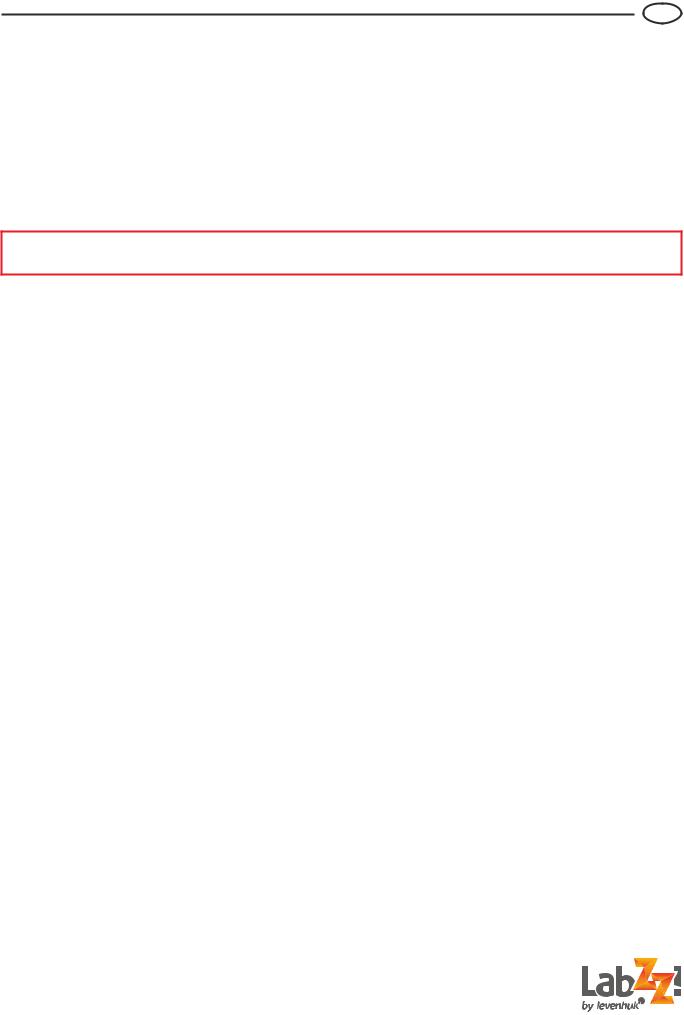
Levenhuk LabZZ MT2 Kit (microscope and telescope)
EN
Dear friend!
Levenhuk LabZZ MT2 Kit for children will open up the amazing world of exciting scientific discoveries! With the telescope in the kit you can study the Moon, planets and bright stars, unravel the mysteries of the endless Cosmos and observe the most distant objects. The microscope, on the other hand, will help you witness the unseen — things so small that you can't see them with the naked eye! The microscope in the kit will help you find out what things around us are made of and what kinds of secrets are hidden from us in every day life. Your experience with Levenhuk LabZZ MT2 Kit will be both informative and entertaining.
Carefully read the entire manual before operating the telescope or microscope. Don't lose it; you might need it later.
Information for parents
Dear adults! Remember that you are responsible for your child at all times. Always ensure the child's safety when working with the microscope or telescope. Read this entire manual carefully, especially the handling and maintenance instructions. Even if your child is old enough and reads well, repeat all the rules aloud one more time before beginning to work with the instruments. Make sure that he or she clearly understands these instructions.
CAUTION! CHOKING HAZARD! These devices include small parts. The telescope and microscope are designed for children over 5 years of age and should only be used under adult supervision.
Care and maintenance (microscope and telescope)
џNever, under any circumstances, look directly at the Sun through this device without a special filter, or look at another bright source of light or at a laser, as this may cause PERMANENT RETINAL DAMAGE and may lead to BLINDNESS.
џYou should ONLY observe the Sun with a professional solar aperture filter that completely covers the front of the instrument. The front end of the finderscope must be covered with aluminum foil or other non-transparent material to protect the internal parts of the telescope from damage. For safe solar observations we recommend using filters with an optical density (OD) of 5.0. Such filters transmit only 0.001% of the
sun's light, blocking the remaining 99.999%. Most reliable solar filters are made of Baader AstroSolar film.
џ Take necessary precautions when using the device with children or others who have not read or who do not fully understand these instructions.
џAll parts of the telescope and microscope will arrive in one box. Be careful when unpacking it. We recommend keeping the original shipping containers. In the event that the telescope needs to be shipped to another location, having the proper shipping containers will help ensure that your telescope survives the journey intact. Make sure all the parts are present in the packaging. Be sure to check the box carefully, as some parts are small.
џDo not try to disassemble the device on your own for any reason. For repairs and cleaning of any kind, please contact your local specialized service center.
џDo not touch the optical surfaces with your fingers. To clean the device exterior, use only special cleaning wipes and special optics cleaning tools from
Levenhuk. Do not use any corrosive or acetone-based fluids to clean the optics.
џ Protect the device from sudden impact and excessive mechanical force. Do not apply excessive pressure when adjusting focus. Do not overtighten the locking screws.
џStore the device in a dry, cool place away from hazardous acids and other chemicals, away from heaters, open fire and other sources of high temperatures.
џIf you are not using the device for extended periods of time, store the objective lenses and eyepieces separately from it.
џ |
Be careful during your observations, always replace the |
dust |
cover after you |
are finished with observations to |
protect |
the |
device |
|
from dust and stains. |
|
|
|
|
|
|
џ |
Do not use the device for lengthy periods of time, or |
leave |
it unattended |
in direct sunlight. Keep the device |
away |
from |
water |
|
and high humidity. |
|
|
|
|
|
|
џWhen using the microscope, try not to use it near flammable materials or substances (benzene, paper, cardboard, plastic, etc.), as the base may heat up during use, and might become a fire hazard.
џAlways unplug the microscope from a power source before opening the base or changing the illumination lamp. Regardless of the lamp type (halogen or incandescent), give it some time to cool down before trying to change it, and always change it to a lamp of the same type.
џThe chemicals might be harmful to human health. Use only those specified in the user manual. Make sure that your child knows how to use with
them correctly.
џ The workplace should be kept clean and tidy. Don't work with specimens in the kitchen near food you eat. The area should be well lit. You also should have fast and convenient access to clean water.
џFind a separate bucket for waste. All liquids should be poured down the drain, not into the sink.
џDyes: methylene blue and methyl orange. Do not swallow. Keep out of the reach of children. If swallowed, seek medical advice immediately.
џGlue: usually organic material (for example, pitch). Do not swallow. Keep out of the reach of children. If swallowed, seek medical advice immediately.
џThe kit includes everything needed for assembly, but if you need some additional tool you can use a basic set of standard instruments that almost everyone keeps at home.
џSeek medical advice immediately if a small part or a battery is swallowed.
џChildren should use the telescope under adult supervision only.
Batteries safety instructions
џAlways purchase the correct size and grade of battery most suitable for the intended use.
џAlways replace the whole set of batteries at one time; taking care not to mix old and new ones, or batteries of different types.
џClean the battery contacts and also those of the device prior to battery installation.
џMake sure the batteries are installed correctly with regard to polarity (+ and -).
џRemove batteries from equipment that is not to be used for an extended period of time.
џRemove used batteries promptly.
џNever attempt to recharge primary batteries as this may cause leakage, fire, or explosion.
џNever short-circuit batteries as this may lead to high temperatures, leakage, or explosion.
џNever heat batteries in order to revive them.
3
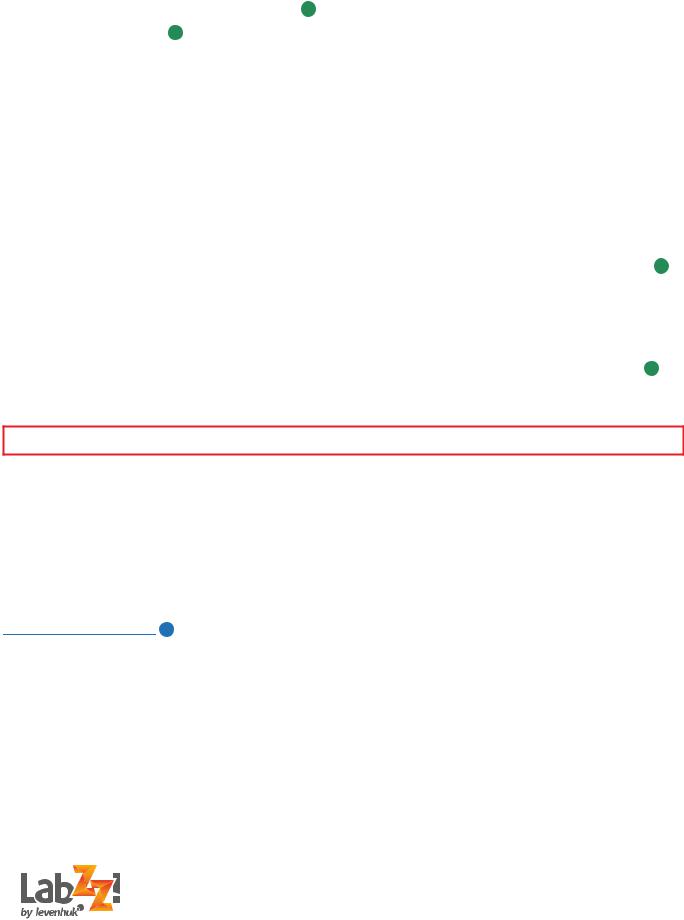
џDo not disassemble batteries.
џRemember to switch off devices after use.
џKeep batteries out of the reach of children, to avoid risk of ingestion, suffocation, or poisoning.
џUtilize used batteries as prescribed by your country laws.
Welcome to the microworld!
With Levenhuk LabZZ MT2 Microscope you will make lots of interesting discoveries and create exciting memories! Remember that following safety rules is absolutely necessary. In the kit you will find the microscope, as well as many useful accessories. Everything in place? Check together with your parents. 4
Microscope's construction 1
1.Eyepiece. You observe the magnified image of the sample through the eyepiece. Eyepiece is a lens system that works the same way as a magnifying glass.
2.Focusing knob. Blurry images? Rotate the knob gently, adjusting the focus until all details become clear. Be careful – rotate the knob slowly so as not to damage the objective or observed slide.
3.Monocular head. This is a very important part of the microscope. The light travels right up the tube of the head directly into the eyepiece, where the resulting image is formed.
4.Revolving nosepiece. This is a device that holds three objectives with different magnifications. To change magnification, rotate the nosepiece until it clicks (the sound means that the chosen objective is in place).
5.Objective. This is needed for magnifying images. Levenhuk LabZZ MT2 Microscope comes with three objectives with different magnifications. They magnify images 75, 300 and 900 times compared to what you see with the naked eye.
6.Stand. This curved part of the microscope connects all other parts together. If you are feeling uncomfortable looking through the eyepiece, tilt or lift the stand until it's more comfortable. Change the inclination angle slowly, without abrupt movements.
7.Stage. This is exactly where you place the slide in order to observe it.
8.The stage has two slide holders, which, as is clear from their name, hold slides in place.
9.The mirror is located under the stage. It refracts the light from the lamp or the window illuminating the sample on the stage.
10.Illumination lamp. If illumination in your room is not enough, turn on the built-in illumination by turning over the mirror. 2
11.Battery compartment. The battery compartment is in the base of the microscope. What's it for? That's simple — it's where you put batteries to make the illumination work. More details on how it's done can be found below.
How to work with the microscope
1.First install batteries for illumination. Flip the microscope over and remove the cap from the battery compartment. Insert two AA batteries (those are not the thinnest penlight batteries, but those that are a bit thicker). Insert the batteries according to
their polarity — make sure that the “+” sign on the battery matches “+” in the compartment (same goes for “-” signs). 3 Put the cap back on. Don't hesitate to ask adults for help if you are not sure.
2.Place the microscope on the flat surface near the source of bright light (window or a lamp). Turn the mirror towards the illumination source. You should see a bright light spot through the eyepiece.
CAUTION! Never direct the mirror towards the Sun, as it may ruin your eyesight and even cause blindness.
3.Now the microscope is ready for work.
4.Take a prepared microscope slide, place it on the stage and secure with holders.
5.Choose the objective by rotating the revolving nosepiece. The microscope comes with three objectives with different magnifications. The longer the objective, the higher magnification it produces. Most observations are better performed with lower magnification, so choose the shortest objective to start. You will hear a “click” when the objective is in place.
6.Slowly rotate the focusing knob so the objective is almost touching the slide. BUT! It shouldn't actually touch the slide as both the slide and the objective may be damaged if it does. That's why you need to do everything very slowly and carefully. When the objective is very close to the slide (but doesn't touch it!), look through the eyepiece and start to rotate the focusing knob in the opposite direction very slowly until you see a clear image.
Wonderful telescope
Telescope's construction 5
1.Objective. The most important part of the telescope. The objective is a lens system that gathers light from the distant object and forms its image. The objective should always be pointed in the direction of the object you want to observe.
2.Optical tube. Light rays collected by the objective travel down the optical tube to enter the eyepiece.
3.Eyepiece. You look at the Moon, planets and stars through the eyepiece. The eyepiece enlarges images of objects many times; that's why all objects look bigger than when observed with the naked eye.
4.Sun shade. The shade is a short tube that is put on the objective. It's needed to not let the light from street lamps, car lights, windows and other close-by light sources get in the objective and ruin the resulting image of the object you want to observe.
5.Finderscope — is a small telescope that is attached to the tube of the big telescope. The finderscope has small magnification and wide field of view (the latter means that you can see larger areas at once). The finderscope is made to help you find the desired object more quickly and easily. After you've found the object using the finderscope, you can observe it in detail through the telescope.
6.Finderscope bracket is required to attach the finderscope to the telescope tube.
7.Focuser — is a special device in which the eyepiece is inserted. The focuser is needed for bringing the eyepiece closer or farther from the objective. By doing so, you can achieve the maximum clarity of images.
4
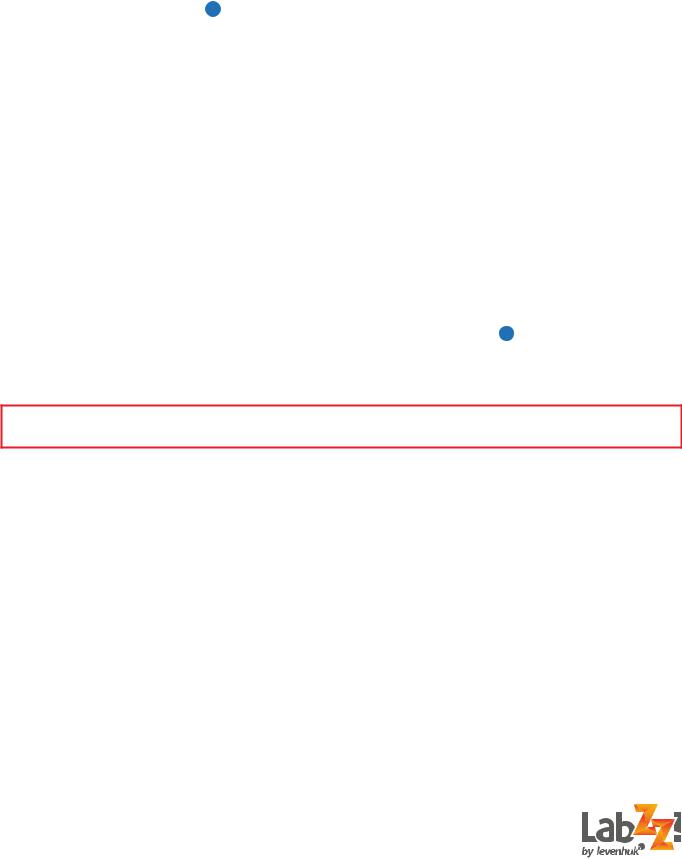
8.If the image you see through the eyepiece isn't clear, rotate the focusing knob carefully.
9.Diagonal mirror. If you want to observe objects high above your head, use the diagonal mirror so you don't have to throw your head back. The diagonal mirror is inserted in the focuser. It deflects light rays so you can observe from a more comfortable position.
10.Altazimuth mount — is a special mechanism that allows you to move the telescope tube up-down and right-left.
11.Azimuth lock knob moves the tube horizontally.
12.Altitude lock knob moves the tube vertically.
13.Slow-motion control. The telescope is a very sensitive instrument; that's why for more precise pointing you need to use slow-motion control. This control allows you to move the tube very smoothly and without jumps.
14.Tabletop tripod. The telescope should be very stable so the images you see don't shake. This is why the tube is installed on a special support — the tripod.
How to assemble your telescope 6
It is very important to assemble the telescope correctly so it works the right way. Examine the telescope carefully. Try to remember the names of its parts, where each part goes and what it's needed for. It's better to assemble the telescope with adult help.
1.Open the box and put out all the parts. Double-check the box when it's empty — some small parts might still be in there.
2.Spread the tripod legs and install it on a flat surface so it is stable.
3.Find the mounting screw on the telescope (located underneath). Loosen it and set the telescope on the mount. Insert the screw in the holes on the telescope and the mount. Carefully tighten it. Attention: Do not overtighten the screw as you may accidentally damage the screw thread.
4.Loosen the finderscope mounting screws and slide it in the finderscope base. Carefully tighten the screws. The finderscope should be installed in a way so it points in the same direction as the telescope tube.
How to work with the telescope
Before starting observations it is very important to install eyepieces and all additional parts correctly.
Focuser: Turn the focusing knob toward the telescope until it will not go farther. Then start turning the knob towards yourself slowly until the image is clear. Attention: Before focusing the view (adjusting its sharpness), make sure that eyepiece is inserted in the focuser. Otherwise, you won't see an image.
18mm eyepiece: In the box with your telescope you will find two eyepieces. The lower the number on the eyepiece, the higher the magnification. It's better to start observing using an eyepiece with low magnification and wide field of view. The 18mm erecting eyepiece can be used for lunar and planetary observations and you can also observe a great number of distant terrestrial objects with it such as buildings, towers, antennas and others! Attention: The 18mm erecting eyepiece should be inserted directly into the focuser, without the diagonal mirror.
Diagonal mirror: Pull out the erecting eyepiece and insert the diagonal mirror into the focuser. 7
H12.5mm eyepiece: After the diagonal mirror is inserted into the focuser, insert the H12.5mm eyepiece in it. It provides higher magnification and is great for night-time observations.
How to start observing
CAUTION! Never look at the Sun and the sky around it through a telescope!
It can ruin eyesight and even cause blindness!
Before you start exploring the Cosmos, you should learn to operate the telescope during the day. Use the 18mm erecting eyepiece to observe different terrestrial objects — houses, trees, antennas on the rooftops and many others! This way you will learn to control the telescope and focus on desired objects. Besides, it's a lot of fun! Attention: The telescope should be used in a place protected from the wind.
When you get to observing the Moon, planets and stars at night, remember to choose locations away from street lamps, car lights and window lights. Try to observe on nights when the stars shine bright and evenly.
Point the telescope at the desired object, for example, the Moon. Looking through the finderscope, slowly move the tube until the object is in the center. Now look through the eyepiece and you will see the image of the object magnified many times!
When working with the telescope, be careful and patient. Don't push it and don't move it from its place. After some training you will learn to move the telescope tube without losing the object from the sight of the eyepiece.
5
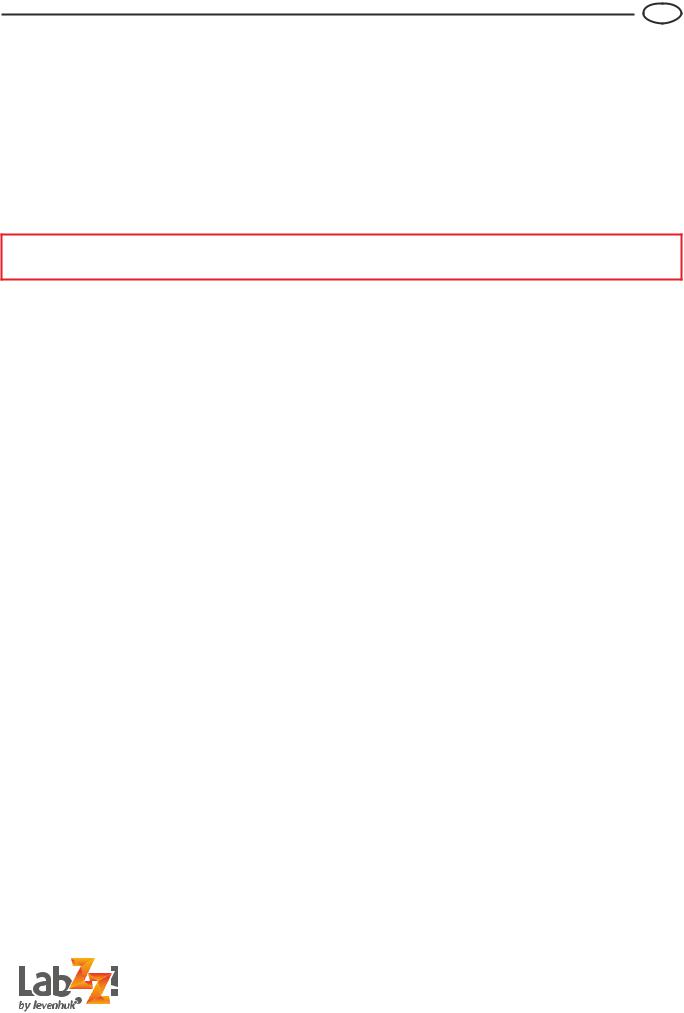
Sada Levenhuk LabZZ MT2 (mikroscop a teleskop)
CZ
Vážení přátelé!
Sada Levenhuk LabZZ MT2 pro děti jim otevírá bránu do úžasného světa vzrušujících vědeckých objevů! Pomocí teleskopu v sadě můžete studovat Měsíc, planety a jasné hvězdy, odhalovat záhady nekonečného vesmíru a pozorovat nejvzdálenější objekty. Naopak mikroskop vám pomůže spatřit to, co jste dosud neměli šanci zahlédnout — věci tak malé, že je prostým okem nemůžete uvidět! Mikroskop v sadě vám pomůže zjistit, z čeho se skládají věci kolem nás a jaké typy záhad se před námi v každodenním životě skrývají. Vaše zážitky se sadou Levenhuk LabZZ MT2 budou poučné i zábavné.
Před zahájením práce s teleskopem nebo mikroskopem si pozorně přečtěte celý návod. Neztraťte jej, může se vám později hodit.
Informace pro rodiče
Vážení dospělí! Nezapomínejte na to, že za své děti vždy odpovídáte vy sami. Při práci s mikroskopem nebo teleskopem neustále dbejte na bezpečnost dítěte. Pozorně si pročtěte celý návod, zejména pokyny týkající se manipulace a údržby. I když je vaše dítě dostatečně staré a dobře čte, zopakujte mu před zahájením práce s přístrojem ještě jednou všechny pokyny. Ujistěte se, že tyto pokyny dobře chápe.
POZOR! NEBEZPEČÍ UDUŠENÍ! Přístroje obsahují malé součásti. Teleskop a mikroskop je určen pro děti ve věku nad 5 let a měly by se používat pouze pod dohledem dospělé osoby.
Péče a údržba (mikroskop a teleskop)
џNikdy, za žádných okolností se tímto přístrojem nedívejte přímo do slunce, jiného světelného zdroje nebo laseru, neboť hrozí nebezpečí TRVALÉHO POŠKOZENÍ SÍTNICE a případně I OSLEPNUTÍ.
џPoužívejte výhradně profesionální sluneční filtry, které kompletně překrývají objektiv mikroskopu. Přední strana hledáčku (pointačního dalekohledu) musí být zakryta aluminiovou fólií nebo jiným neprůhledným materiálem, který chrání vnitřní součásti dalekohledu před poškozením. K bezpečnému pozorování slunce doporučujeme používat filtry s optickou hustotou (OD) hodnoty 5.0. Tyto filtry propouštějí pouze 0,001 % slunečního světla a odstiňují zbylých 99,999 %. Nejspolehlivější sluneční filtry se vyrábějí z fólie Baader AstroSolar.
џPři použití tohoto přístroje dětmi nebo osobami, které tento návod nečetly nebo s jeho obsahem nebyly plně srozuměny, uplatněte nezbytná preventivní opatření.
џVšechny součásti teleskopu a mikroskopu jsou dodávány v jediné krabici. Při jejím vybalování postupujte opatrně. Doporučujeme vám uschovat si originální přepravní obaly. V případě, že bude potřeba teleskop přepravit do jiného místa, mohou správné přepravní obaly pomoci předejít jeho poškození při přepravě. Přesvědčte se, zda jsou v obalu všechny součásti. Obsah důkladně zkontrolujte, neboť některé součásti jsou malé.
џPři použití tohoto přístroje dětmi nebo osobami, které tento návod nečetly nebo s jeho obsahem nebyly plně srozuměny, uplatněte nezbytná preventivní opatření.
џNedotýkejte se svými prsty povrchů optických prvků. K vyčištění vnějších částí přístroje používejte výhradně speciální čisticí ubrousky a speciální nástroje k čištění optiky dodávané společností Levenhuk. K čištění optiky nepoužívejte žádné žíraviny ani kapaliny na acetonové bázi.
џPřístroj chraňte před prudkými nárazy a nadměrným mechanickým namáháním. Při zaostřování nevyvíjejte nadměrný tlak. Neutahujte šrouby konstrukce příliš silně.
џPřístroj ukládejte na suchém, chladném místě, mimo dosah nebezpečných kyselin nebo jiných chemikálií, topných těles, otevřeného ohně a jiných zdrojů vysokých teplot.
џPokud svůj přístroj nebudete delší dobu používat, uložte čočky objektivu a okuláru odděleně od něho.
џPři pozorování dbejte na opatrnost; po skončení pozorování vždy nasaďte ochranný kryt, abyste přístroj ochránili před prachem a jiným znečištěním.
џPřístroj příliš dlouho nepoužívejte ani neponechávejte bez dozoru na přímém slunci. Chraňte přístroj před stykem s vodou.
џMikroskop nepoužívejte v blízkosti hořlavých materiálů nebo látek (benzín, papír, lepenka, plast apod.), neboť stativ se může při práci zahřívat a vyvolávat riziko požáru.
џPřed otevřením stativu nebo výměnou žárovky osvětlení vždy mikroskop odpojte od zdroje napájení. Bez ohledu na typ žárovky (halogenová nebo obyčejná) ji nechejte před výměnou nějakou dobu vychladnout a vždy ji vyměňujte za žárovku stejného typu.
џChemické sloučeniny mohou být lidskému zdraví škodlivé. Používejte pouze ty, které jsou uvedeny v návodu. Ujistěte se, zda vaše dítě ví, jak je má správně používat.
џPracoviště je potřeba udržovat v čistotě a pořádku. S preparáty nepracujte v kuchyni a v blízkosti potravin. Prostor by měl být dobře osvětlen. Dále je potřeba zajistit rychlý a pohodlný přístup k čisté vodě.
џPoužívejte samostatnou nádobu na odpad. Veškeré kapaliny je nutné vylévat přímo do kanalizace, ne do kuchyňské výlevky.
џBarviva: methylenová modř a oranž methylová. Nepolykejte. Udržujte mimo dosah dětí. V případě požití ihned vyhledejte lékařskou pomoc.
џLepidlo: obvykle organický materiál (například na bázi dehtu). Nepolykejte. Udržujte mimo dosah dětí. V případě požití ihned vyhledejte lékařskou pomoc.
џTato sada obsahuje vše potřebné k montáži, ale budete-li potřebovat další pomůcky, můžete použít základní sadu standardních nástrojů, které má prakticky každý doma.
џPři náhodném požití malé součásti nebo baterie ihned vyhledejte lékařskou pomoc.
џDěti by měly teleskop používat pouze pod dohledem dospělé osoby.
Bezpečnostní pokyny týkající se baterií
џVždy nakupujte baterie správné velikosti a typu, které jsou nejvhodnější pro zamýšlený účel.
џPři výměně vždy nahrazujte celou sadu baterií a dbejte na to, abyste nemíchali staré a nové baterie, případně baterie různých typů.
џPřed instalací baterií vyčistěte kontakty na baterii i na přístroji.
џUjistěte se, zda jsou baterie instalovány ve správné polaritě (+ resp. -).
џV případě, že zařízení nebudete delší dobu používat, vyjměte z něj baterie.
џPoužité baterie včas vyměňujte.
џBaterie se nikdy nepokoušejte dobíjet, mohlo by dojít k úniku obsahu baterie, požáru nebo k explozi.
6
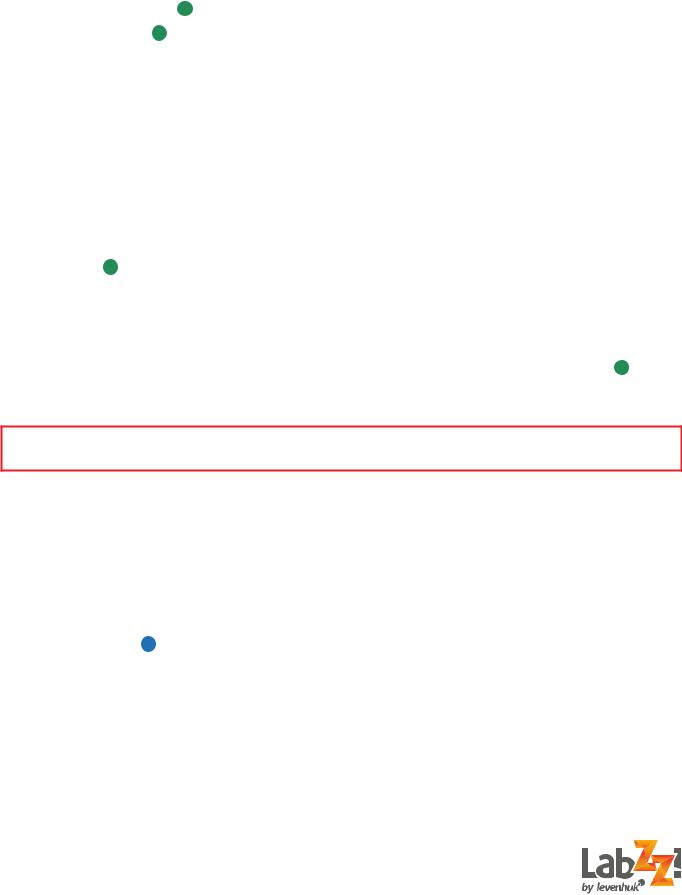
џBaterie nikdy nezkratujte, mohlo by to vést ke zvýšení teploty, úniku obsahu baterie nebo k explozi.
џBaterie se nikdy nepokoušejte oživit zahříváním.
џNepokoušejte se rozebírat baterie.
џPo použití nezapomeňte přístroj vypnout.
џBaterie uchovávejte mimo dosah dětí, abyste předešli riziku spolknutí, vdechnutí nebo otravy.
џS použitými bateriemi nakládejte v souladu s vašimi vnitrostátními předpisy.
Vítejte v mikrosvětě!
S mikroskopem Levenhuk LabZZ MT2 uděláte řadu zajímavých objevů a získáte vzrušující vzpomínky! Pamatujte, že je naprosto nezbytné dodržovat bezpečnostní pravidla. V krabici naleznete mikroskop i mnoho užitečného příslušenství. Je všechno na místě? Zkontrolujte to společně s rodiči. 4
Konstrukce mikroskopu 1
1.Okulár. Přes okulár pozorujete zvětšený obraz preparátu. Okulár je soustava čoček, která funguje stejně jako lupa.
2.Zaostřovací šroub. Neostrý obraz? Opatrně otáčejte šroubem a seřizujte zaostření, dokud nebudou zřetelné všechny detaily. Postupujte opatrně — šroubem otáčejte pomalu, abyste nepoškodili objektiv nebo pozorovaný preparát.
3.Monokulární hlava. Je velmi důležitou součástí mikroskopu. Světlo putuje tubusem hlavy přímo do okuláru, kde se vytváří výsledný obraz.
4.Revolverový nosič objektivů. Jedná se o zařízení, které nese tři objektivy nabízející různé zvětšení. Chcete-li změnit zvětšení, otočte nosičem, dokud neuslyšíte kliknutí (tento zvuk znamená, že je vybraný objektiv na svém místě).
5.Objektiv. Je potřeba ke zvětšení obrazu. Mikroskop Levenhuk LabZZ MT2 je vybaven třemi objektivy, které nabízejí různé hodnoty zvětšení. V porovnání s tím, co vidíte prostým okem, zvětšují obraz 75x, 300x a 900x.
6.Stativ. Tato zakřivená část mikroskopu spojuje všechny ostatní součásti. Necítíte-li se při pohledu přes okulár pohodlně, stativ nakloňte nebo zvedněte, dokud nebude poloha pohodlnější. Úhel naklonění měňte pomalu, nepoužívejte prudké pohyby.
7.Pracovní stolek. Místo, na které položíte preparát, abyste jej mohli pozorovat.
8.Stolek je vybaven dvěma držáky preparátů které – jak je patrno z jejich názvu — drží preparát na místě.
9.Pod pracovním stolkem se nachází zrcátko. To odráží světlo lampy nebo okna a osvětluje preparát na pracovním stolku.
10.Osvětlovací těleso. Pokud nebude osvětlení v místnosti postačující, zapněte otočením zrcátka integrovaný světelný zdroj. 2
11.Prostor pro baterie. Prostor pro baterie se nachází ve spodní části stativu mikroskopu. K čemu je dobrý? To je jednoduché — vkládají se do něj baterie k napájení osvětlení. Další informace o tom, jak se to provádí, lze nalézt níže.
Práce s mikroskopem
1.Nejprve nainstalujte baterie pro osvětlení. Otočte mikroskop vzhůru nohama a sejměte víčko z prostoru pro baterie. Vložte dvě baterie velikosti AA (nejedná se o nejtenčí tužkové baterie, ale o jednu velikost větší). Baterie vložte ve správné
polaritě — značka „+“ na baterii musí odpovídat značce „+“ v prostoru pro baterie (totéž platí i pro značky „-“). 3 Nasaďte zpět víčko. Pokud si něčím nebudete jisti, nestyďte se požádat o pomoc dospělé.
2.Mikroskop postavte na rovný povrch poblíž jasného světelného zdroje (okna nebo lampy). Zrcátko otočte směrem ke světelnému zdroji. Přes okulár byste měli vidět jasný světelný kruh.
DŮLEŽITÉ UPOZORNĚNÍ! Mikroskop nikdy neotáčejte směrem ke Slunci, mohli byste si poškodit zrak nebo dokonce oslepnout.
3.Nyní je mikroskop připraven k použití.
4.Vezměte připravený preparát, položte jej na pracovní stolek a upevněte svorkami.
5.Pootočením revolverové hlavice vyberte objektiv. Mikroskop je vybaven třemi objektivy, které nabízejí různé hodnoty zvětšení. Čím delší je objektiv, tím vyšší hodnotu zvětšení nabízí. Většinu pozorování je vhodné provádět při nižším zvětšení, takže si pro začátek vyberte nejkratší objektiv. Jakmile bude objektiv na svém místě, uslyšíte cvaknutí.
6.Zvolna otáčejte zaostřovacím šroubem tak, aby se krycí sklíčko preparátu téměř dotýkalo čočky objektivu. ALE! Objektiv by se nikdy neměl dotknout preparátu, neboť v tom případě by se mohl objektiv i preparát poškodit. Proto musíte vše dělat velmi pomalu a opatrně. Až bude objektiv těsně u sklíčka preparátu (ale nedotkne se jej), podívejte se přes okulár a začněte zaostřovacím šroubem otáčet opačným směrem, dokud neuvidíte čistý obraz.
Úžasný teleskop
Konstrukce teleskopu 5
1.Objektiv. Nejdůležitější součást teleskopu. Objektiv je systém čoček, které zachycují světlo přicházející ze vzdáleného objektu a utvářejí jeho obraz. Objektiv je potřeba vždy namířit směrem k objektu, který chcete pozorovat.
2.Optický tubus. Světelné paprsky zachycené objektivem putují optickým tubusem směrem dolů a vstupují do okuláru.
3.Okulár. Přes okulár se díváte na Měsíc, planety a hvězdy. Okulár mnohonásobně zvětšuje obraz pozorovaného objektu. Proto se všechny objekty jeví větší, než když je pozorujeme prostým okem.
4.Sluneční clona. Tato clona je krátká trubice umístěná na tubus. Je potřebná k odstínění světla z pouličního osvětlení, reflektorů vozidel, osvětlených oken a jiných blízkých světelných zdrojů, aby neproniklo do objektivu a nezničilo výsledný obraz objektu, který chcete pozorovat.
5.Hledáček neboli pointační dalekohled — jedná se o malý dalekohled připojený k tubusu velkého teleskopu. Hledáček má malé zvětšení a široké zorné pole (to znamená, že můžete v jednom záběru pozorovat velké oblasti). Slouží k tomu, aby vám pomohl jednodušeji a rychleji najít požadovaný objekt. Jakmile objekt zaměříte hledáčkem, můžete jej detailně pozorovat teleskopem.
7
